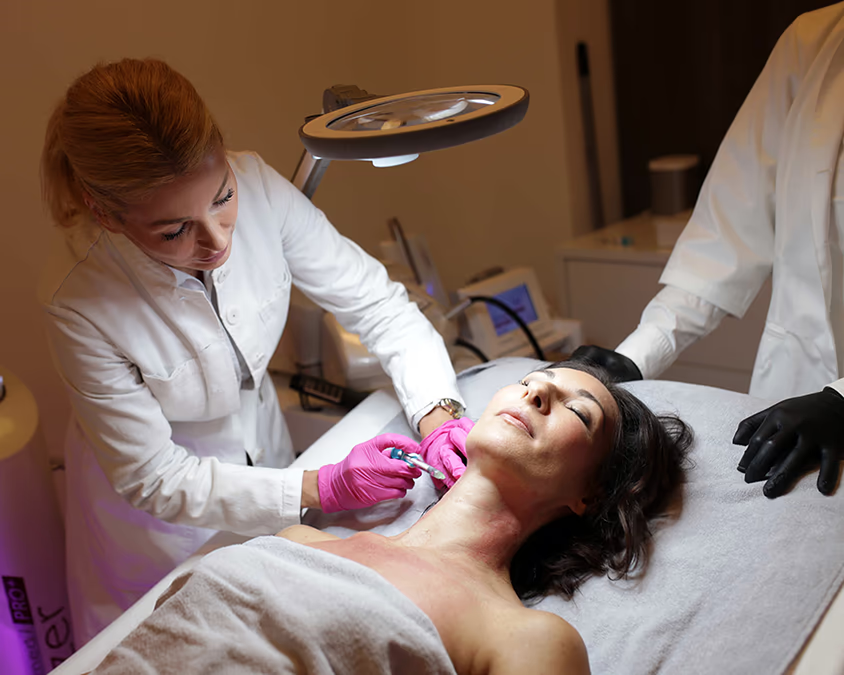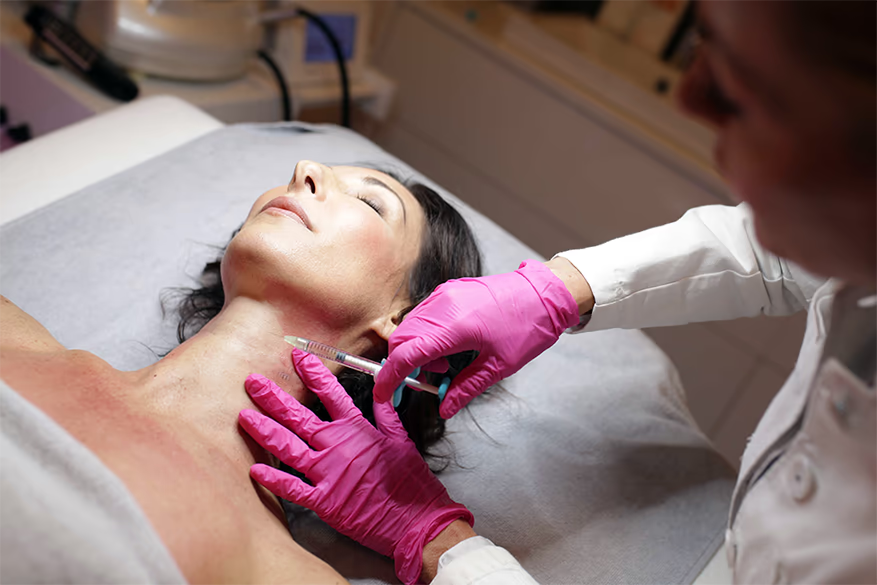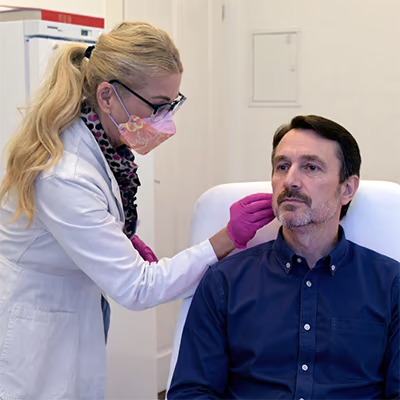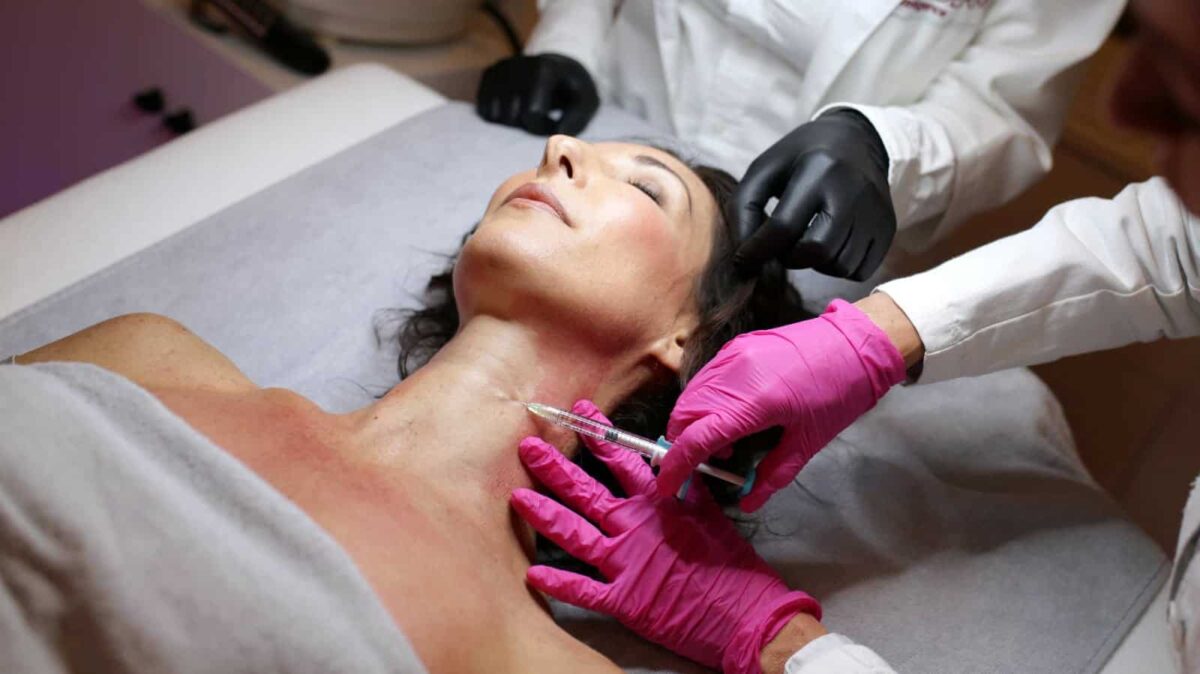Gentle Dermal Filler Treatment for a Fresh, Revitalized Appearance

Dermal Filler Treatments at a Glance
- During a dermal filler treatment, a gel based on hyaluronic acid fillers is injected into the skin to restore volume, smooth facial wrinkles, and visibly improve skin texture.
- The effects of a hyaluronic acid treatment typically last 6 to 18 months, depending on the product used and the individual’s metabolism.
- Before the hyaluron injection, a local anesthetic may be applied; many fillers already contain a numbing agent for maximum comfort.
- Possible side effects: mild redness, swelling, bruising, and in rare cases, infection or allergic reactions.
- There is no downtime—you can resume normal social activities immediately after the dermal filler treatment.
- The treatment time is about 45–60 minutes for the initial session and 30–45 minutes for follow-up appointments.
- Dermal filler treatments in my practice start at around €300 (indicative, billed according to the German Medical Fee Schedule [GOÄ]).

Table of Contents
- What Is a Dermal Filler Treatment?
- How Do Hyaluronic Acid Fillers Work?
- Which Areas Can Be Treated With Fillers?
- My Approach to Dermal Filler Treatments
- Treatment Process
- Results and Longevity
- Risks and Possible Side Effects
- Prices for Dermal Filler Treatments
- Why Choose Dr. Strobl for Dermal Fillers in Munich?
- FAQ – Dermal Filler Treatment

What Is a Dermal Filler Treatment?
A dermal filler treatment is a well-established method in aesthetic medicine to rejuvenate the face and smooth facial lines without altering natural expression. During the treatment, a hyaluronic acid–based gel—a substance naturally found in the body—is carefully injected into the skin to restore volume, lock in moisture, and improve skin texture.
Natural Results With Advanced Hyaluronic Acid Fillers
For each dermal filler treatment, I use high-quality hyaluronic acid fillers designed specifically for facial volume restoration and wrinkle correction. These fillers vary in consistency and crosslinking density, allowing for a highly individualized approach—from smoothing fine lip lines to enhancing the cheeks or performing precise jawline contouring. The outcome is a fresh, balanced look with a natural result—never overdone.
How Hyaluronic Acid Injections Work
The effect of a hyaluronic acid injection is immediate: the gel fills wrinkles, lifts sunken areas, and restores firmness to the skin. It also stimulates natural collagen production, which helps improve skin tone and elasticity over time. This treatment is particularly effective to soften nasolabial folds, reduce marionette lines, and treat fine surface wrinkles. Thanks to hyaluronic acid’s strong ability to bind water, the skin becomes deeply hydrated, appearing plumper, smoother, and more radiant.
Safe, Precise, and Individually Tailored
At my aesthetic practice in Munich, I place great emphasis on precise facial analysis and expert injection technique. Each treatment is customized to the patient’s skin type, age, and aesthetic goals. As an experienced physician specializing in hyaluronic fillers, I use only FDA- and CE-certified premium fillers from leading manufacturers to ensure maximum safety and compatibility. A dermal filler treatment in Munich is minimally invasive, well tolerated, and requires no downtime. The result is smoother, naturally refreshed skin—without surgery.
How Do Hyaluronic Acid Fillers Work?
Hyaluronic acid is a natural component of the connective tissue that can store large amounts of water, helping the skin maintain firmness, elasticity, and a fresh appearance. As we age, the body’s hyaluronic acid levels decrease, the tissue loses volume, and wrinkles begin to form. A dermal filler treatment helps restore this loss, creating smoother, more radiant skin.
Structure and Effect of a Dermal Filler Treatment
During a treatment, a cross-linked hyaluronic acid filler is injected into the mid to deep layers of the skin. The filler injection immediately smooths wrinkles and adds natural-looking volume. This effect results from the water-binding capacity of hyaluronic acid, which hydrates and plumps the skin from within.
Long-Term Skin Improvement With Hyaluronic Acid and HArmonyCa
Beyond the immediate smoothing effect, hyaluronic acid fillers also support collagen and elastin regeneration over time. A combination treatment with HArmonyCa goes one step further: it contains calcium hydroxyapatite, which specifically stimulates the body’s collagen production. The result is a dual effect—instant volume from hyaluronic acid and long-lasting skin tightening from new collagen formation. This approach is ideal for patients seeking comprehensive facial rejuvenation with structural improvement.
Precise Application for Natural Results
Depending on the treatment goal, hyaluronic acid can be injected superficially or deeply—to soften nasolabial folds, reduce marionette lines, smooth lip wrinkles, or achieve cheek enhancement. Jawline contouring with hyaluronic acid further helps define the facial profile and restore balanced proportions. In my practice, I focus on individualized planning, precise injection technique, and natural results without overcorrection.
A professionally performed dermal filler treatment combines precision, safety, and aesthetic harmony—for skin that looks refreshed yet authentic.
Which Areas Can Be Treated With Dermal Filler?
Dermal filler treatment is suitable for nearly all facial areas where volume loss or visible wrinkles affect the appearance. With precise hyaluronic acid injections, both deep folds and fine lines can be smoothed, restoring balanced and naturally contoured facial features.
Nasolabial Folds
The nasolabial folds run between the nose and the corners of the mouth and are among the most common signs of aging. A targeted hyaluronic acid filler treatment in this area gently lifts the skin, giving the face a softer and more relaxed appearance.
As we age, the nasolabial folds deepen due to loss of fat and connective tissue volume and decreasing skin elasticity. With precise dermal filler injections, this area can be effectively smoothed without altering natural facial expressions.
The hyaluron injection restores lost volume, lifts the contours, and creates a more harmonious and refreshed facial appearance.
Marionette Lines
The marionette lines extend from the corners of the mouth down toward the chin and can give the face a tired or sad look. A carefully placed dermal filler treatment can smooth these lines and visibly rejuvenate the lower face.
With hyaluronic acid fillers, the area around the mouth corners is lifted and redefined. The hyaluron injection strengthens the skin’s structure, improves firmness, and creates a smoother transition between the cheek and chin.
The result is a naturally refreshed and friendly appearance without overcorrection.
Perioral Lines
Fine perioral lines, mainly above the upper lip, often develop due to facial expressions, sun exposure, or the natural aging process. A targeted hyaluronic acid treatment improves skin texture, deeply hydrates the area, and creates smoother, softer lip contours.
A dermal filler treatment delivers the best results when these lines are still fine and not deeply etched. In cases of more pronounced lip wrinkles, restraint is essential—overfilling can cause an unnatural striping effect. In such cases, I like to use low-viscosity fillers such as Skinvive, which were originally designed as skin boosters rather than for wrinkle correction. I also like to combine fillers with skin rejuvenation treatments to achieve a smooth and natural-looking result.
Liquid Lift – Harmonious Facial Contouring with Hyaluronic Acid
A hyaluronic acid treatment can achieve much more than simply smoothing individual wrinkles. Through targeted facial volumization, the overall appearance can be harmonized and rejuvenated. One of the most effective techniques is the Liquid Lift, in which multiple facial areas are subtly reshaped using hyaluronic acid fillers to restore lost volume.
This approach is ideal for cheek enhancement with hyaluronic acid, jawline contouring, or correcting a receding chin. The result is a more defined yet naturally balanced facial profile. My focus is always on achieving natural-looking results without overcorrection—for a refreshed, harmonious appearance with visibly improved contours.
My Approach to Dermal Fillers: Natural-Looking Results Without the “Overfilled” Look

In my work with hyaluronic acid fillers, the focus is always on natural results. The goal is not an “overfilled” look but a balanced, refreshed appearance with fully preserved facial expressions. Every dermal filler treatment is precisely planned and delicately dosed to smooth wrinkles and restore volume—not to alter the face.
My philosophy, “Timeless Beauty at Every Age,” reflects this approach: aesthetic medicine should enhance natural maturity and expression, not conceal them. Whether performing targeted wrinkle correction or a liquid facelift, maintaining balanced proportions is key.
As an experienced aesthetic physician in Munich, I use only premium, FDA-approved fillers and advanced injection techniques. The result: a natural outcome without overcorrection—subtle, balanced, and authentic.
Treatment Process
- Individual Consultation and Analysis
Each treatment begins with a detailed discussion of your goals and a thorough analysis of your facial features, skin texture, and expression patterns. The aim is to create a customized treatment plan that achieves natural results without overcorrection. - Skin Preparation
The skin is carefully cleansed and disinfected. Upon request, a topical numbing cream can be applied for added comfort. Most hyaluronic acid fillers already contain a mild anesthetic for a more pleasant experience. - Precise Hyaluronic Acid Injection
The dermal filler treatment is performed using ultra-fine needles or blunt cannulas. Injection depth and product volume are individually adjusted to each area—whether treating nasolabial folds, marionette lines, or perioral wrinkles. - Assessment and Fine Adjustment
After the hyaluronic acid injection, I immediately evaluate the results and make subtle refinements if needed to ensure symmetry and harmony. - Aftercare and Recommendations
Mild swelling or redness is common and usually subsides within 24 hours. Avoid exercise, sauna, and intense sun exposure for one to two days following the treatment.
Results and Longevity
Instantly Visible Results
The results of a dermal filler treatment are typically visible immediately after the procedure. The face appears fresher, smoother, and more harmonious without losing its natural expression. Through targeted facial volumization, the skin gains internal support and improved firmness.
Improved Skin Quality
Beyond the immediate smoothing effect, hyaluronic acid fillers also stimulate collagen and elastin production, leading to long-term improvement in skin quality. With regular treatments, a cumulative rejuvenation effect can be observed—the skin remains smoother and more elastic over time.
Longevity and Lasting Results
The duration of results depends on product quality, injection depth, treatment area, and individual metabolism. On average, results last 6 to 18 months. In highly expressive areas such as around the mouth, hyaluronic acid tends to break down slightly faster than in less mobile zones like the cheeks or chin.
Collagen Stimulation with HArmonyCa
The HArmonyCa treatment holds a special place among filler options: it combines hyaluronic acid with calcium hydroxyapatite, which stimulates the body’s own collagen production. While the hyaluronic acid provides an instant smoothing effect, the deeper skin tightening from new collagen formation becomes visible after about six months—and this effect often lasts significantly longer.
When the results begin to fade, the hyaluronic acid injection can be gently refreshed at any time without creating an overfilled look. My goal is always a natural, balanced outcome that preserves your unique facial expression and rejuvenates your appearance in a subtle, refined way.
Risks and Possible Side Effects
- Allergic Reactions
Although hyaluronic acid fillers are generally very well tolerated, allergic reactions can occur in rare cases—even weeks or months after treatment. They usually present as localized swelling, firmness, or redness and are typically manageable. - Temporary Reactions
Following a hyaluron injection, mild redness, swelling, or bruising may occur. These effects usually subside within a few days. A slight feeling of tightness or tenderness at the injection sites is also normal. - Nodules and Irregularities
In rare cases, small nodules or uneven filler distribution may develop. These reactions are generally temporary and can be corrected if necessary. - Vascular Complications
A rare but potentially serious complication is an accidental injection into a blood vessel, which can impair circulation. The forehead, glabella, and nasal area are considered high-risk regions because important vessels supplying the eyes pass through them. For this reason, I treat these zones with fillers only in select cases and prefer alternative methods whenever possible. - Safety-Oriented Approach
Every procedure is carefully planned following an individual analysis and thorough consultation. The goal is always a natural result without overcorrection, achieved with the highest level of medical safety.
Prices for Dermal Filler Treatments
The following indicative prices apply to dermal filler treatments at my practice in Munich. Individual costs are always calculated according to the German Medical Fee Schedule (GOÄ) and may therefore vary from the listed estimates. Please note that health insurance providers generally do not cover the cost of hyaluronic acid filler treatments.
Scroll
| Treatment | Price (indicative, incl. VAT) |
|---|---|
| Tear through (1ml) | 450-480€ |
| Nasolabial fold (1ml) | 298-450€ |
| Mouth corners (1ml) | 298-450€ |
| Marionette lines (1ml) | 298-450€ |
| Perioral lines (1ml) | 298-450€ |
| Lip augmentatin (1ml) | 298-850€ |
| Chin augmentation (1ml) | 450-1.250€ |
| Cheek lift (1ml) | 520-860€ |
| Liquid lift (3ml) | 770-1.250€ |
| Liquid lift (4ml) | 1.000-1.650€ |
| Skin hydration (1-2ml) | 450-860€ |
| HArmonyCa (1,25ml) | from 560€ |
| PROFHILO Face/Neck (1x2ml) | from 298€ |
| PROFHILO Body/Arms (2x3ml) | from 695€ |
| PhilArt (Polynucleotides, 2ml) | from 320€ |
| Hyalase treatment (150iE) | from 198€ |
| Consultation | 75€ |
FAQ – Dermal Filler Treatment
Yes. Hyaluronic acid can be dissolved with the enzyme hyaluronidase (Hylase). However, since the product is derived from animal tissue, it carries a risk of allergic reactions. For this reason, it should be used only in urgent cases or when significant miscorrections occur.
Complications are rare but can occur. Most are limited to redness, swelling, or bruising, which typically resolve within a few days. In isolated cases, persistent swelling may develop and require dissolving the filler with hyaluronidase. The most serious complication is an accidental vascular injection, where a blood vessel is punctured and blocked. This can lead to tissue damage (necrosis) and, in extreme cases, blindness. Such events are considered medical emergencies and must be treated immediately by an experienced physician using hyaluronidase (Hylase).
No. Hyaluronic acid treatments are not recommended during pregnancy or breastfeeding. While hyaluronic acid itself is a naturally occurring substance, most fillers contain lidocaine, which is contraindicated during this period. In addition, the emergency medication hyaluronidase (Hylase) must also not be used while pregnant or nursing.
At my practice in Munich, I do not treat patients under 18 years of age, or anyone with allergies to filler ingredients or lidocaine. Treatment is also excluded in cases of acute infections, inflammation in the treatment area, or certain autoimmune diseases. Likewise, pregnant and breastfeeding women are not treated.
Autoimmune diseases are often considered a relative contraindication for hyaluronic acid treatments. Clear clinical data proving an increased risk are not yet available, so this caution is largely precautionary. Recent studies increasingly question a blanket exclusion. In practice, the decision is made individually, depending on the type and activity of the disease and the risk of inflammatory flare-ups. The final decision is always made together with the patient after thorough consultation and informed consent.
Yes. For patient safety reasons, I do not perform hyaluronic acid injections on the nose, as this area carries a higher risk of vascular complications. I also treat the forehead and glabella (frown lines) very conservatively, and only after careful risk assessment. Whenever possible, I use alternative treatment options to ensure maximum safety for my patients.

About the Author:
Dr. med. univ. Eva Maria Strobl is the owner of LIPS and SKIN Aesthetic Medicine practice in Munich. She is a trained specialist in general medicine (MedUni Vienna) and has over 10 years of specialization in non-surgical aesthetic procedures. Dr. Strobl is a member of the German Society for Aesthetic Botulinum Therapy e.V. (DGBT), the German Society of Anti-Aging Medicine e.V. (GSAAM) and of Network Global Health. She publishes regularly on her blog and on DocCheck.
Sources for This Content:
Sattler et al, Filler in der ästhetischen Medizin, KVM Verlag
De Maio, MD Codes™: A Methodological Approach to Facial Aesthetic Treatment with Injectable Hyaluronic Acid Fillers, Link
Seo, Facial Volumization with Fillers, Springer


